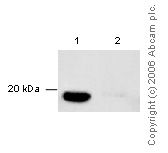Anti-Histone H2A antibody - ChIP Grade
| Name | Anti-Histone H2A antibody - ChIP Grade |
|---|---|
| Supplier | Abcam |
| Catalog | ab15653 |
| Prices | $385.00 |
| Sizes | 100 µg |
| Host | Rabbit |
| Clonality | Polyclonal |
| Isotype | IgG |
| Applications | WB IHC-P ICC/IF ICC/IF ChIP |
| Species Reactivities | Human, Mouse |
| Antigen | Synthetic peptide corresponding to Human Histone H2A aa 100 to the C-terminus (C terminal) conjugated to Keyhole Limpet Haemocyanin (KLH) |
| Blocking Peptide | Human Histone H2A peptide |
| Description | Rabbit Polyclonal |
| Gene | HIST1H2AE |
| Conjugate | Unconjugated |
| Supplier Page | Shop |
Product images
Product References
Human cytomegalovirus IE1 protein disrupts interleukin-6 signaling by - Human cytomegalovirus IE1 protein disrupts interleukin-6 signaling by
Reitsma JM, Sato H, Nevels M, Terhune SS, Paulus C. J Virol. 2013 Oct;87(19):10763-76.
Analysis of chromatin dynamics during glucocorticoid receptor activation. - Analysis of chromatin dynamics during glucocorticoid receptor activation.
Burd CJ, Ward JM, Crusselle-Davis VJ, Kissling GE, Phadke D, Shah RR, Archer TK. Mol Cell Biol. 2012 May;32(10):1805-17.



